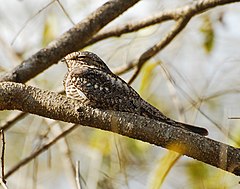Chordeiles – Wikipedia, wolna encyklopedia
| Chordeiles[1] | |||
| Swainson, 1832[2] | |||
 Przedstawiciel rodzaju – lelczyk ostroskrzydły (C. acutipennis) | |||
| Systematyka | |||
| Domena | |||
|---|---|---|---|
| Królestwo | |||
| Typ | |||
| Podtyp | |||
| Gromada | |||
| Podgromada | |||
| Infragromada | |||
| Rząd | |||
| Rodzina | |||
| Podrodzina | |||
| Rodzaj | Chordeiles | ||
| Typ nomenklatoryczny | |||
| Caprimulgus virginianus J.F. Gmelin, 1789 (= Caprimulgus minor J.R. Forster, 1771) | |||
| Synonimy | |||
| | |||
| Gatunki | |||
| |||
Chordeiles – rodzaj ptaków z podrodziny lelków (Caprimulginae) w rodzinie lelkowatych (Caprimulgidae).
Zasięg występowania
[edytuj | edytuj kod]Rodzaj obejmuje gatunki występujące w Ameryce (Kanada, Stany Zjednoczone, Meksyk, Belize, Gwatemala, Salwador, Honduras, Nikaragua, Kostaryka, Panama, Kuba, Bahamy, Jamajka, Haiti, Portoryko, Wyspy Dziewicze, Kolumbia, Wenezuela, Gujana, Surinam, Gujana Francuska, Brazylia, Ekwador, Peru i Argentyna)[8].
Morfologia
[edytuj | edytuj kod]Długość ciała 15–32 cm; masa ciała samców 34–188 g, samic 33,4–170 g[8].
Systematyka
[edytuj | edytuj kod]Etymologia
[edytuj | edytuj kod]- Chordeiles: gr. χορδη khordē „akord”; δειλη deilē „wieczór”[9].
- Podager: łac. podager „człowiek z podagrą”, od podagra „podagra”, od gr. ποδαγρα podagra „podagra”; w aluzji do małych stóp lelczyka dużego które utrudniają mu chodzenie[10]. Gatunek typowy: Caprimulgus diurnus Wied-Neuwied, 1821 (= Caprimulgus nacunda Vieillot, 1817).
- Proithera: gr. πρωι prōi „wczesny, ranny”; -θηρας -thēras „łowca”, od θηραω thēraō „polować”, od θηρ thēr, θηρος thēros „bestia, zwierzę”[11]. Gatunek typowy: Caprimulgus diurnus Wied-Neuwied, 1821 (= Caprimulgus nacunda Vieillot, 1817).
- Microrhynchus: gr. μικρος mikros „mały”; ῥυγχος rhunkhos „dziób”[12]. Gatunek typowy: Caprimulgus exilis Lesson, 1839[a].
- Ramphaoratus: gr. ῥαμφος rhamphos „dziób”; αορατος aoratos „niewidoczny, niewidzialny”[13]. Gatunek typowy: Caprimulgus exilis Lesson, 1839[a].
- Nannochordeiles: gr. ναννος nannos „karzeł”; rodzaj Chordeiles Swainson, 1832 (lelczyk)[14]. Gatunek typowy: Chordeiles ? pusillus Gould, 1861.
Podział systematyczny
[edytuj | edytuj kod]Do rodzaju należą następujące gatunki[15]:
- Chordeiles nacunda – lelczyk duży
- Chordeiles pusillus – lelczyk malutki
- Chordeiles minor – lelczyk mały
- Chordeiles gundlachii – lelczyk antylski
- Chordeiles acutipennis – lelczyk ostroskrzydły
- Chordeiles rupestris – lelczyk blady
Uwagi
[edytuj | edytuj kod]Przypisy
[edytuj | edytuj kod]- ↑ Chordeiles, [w:] Integrated Taxonomic Information System (ang.).
- ↑ W. Swainson: Appendix, No. I.: Characters of Genera and Sub-genera hitherto undefined. W: J. Richardson & W. Swainson: Fauna boreali-americana, or, The zoology of the northern parts of British America: containing descriptions of the objects of natural history collected on the late northern land expeditions under command of Captain Sir John Franklin, R.N.. Cz. 2: The Birds. London: John Murray, 1831, s. 496. (ang.).
- ↑ J.J. Wagler. Mittheilungen über einige merkwürbige Thiere. „Isis von Oken”. 25, s. 277, 1832. (niem.).
- ↑ W. Swainson: On the natural history and classification of birds. Cz. 2. London: John Taylor, 1837, s. 339, seria: Cabinet cyclopaedia. Natural history. (ang.).
- ↑ R.-P. Lesson. Index ornithologique. „L’Écho du monde savant et l’Hermès”. 10, s. 109, 1843. (łac.).
- ↑ Ch.-L. Bonaparte. Parallelismo fra la tribu’ dei cantori fissirostri e quella dei volucri hianti e dei notturni ovvero insidenti. „Rivista Contemporanea”. 9, s. 215, 1857. (wł.).
- ↑ E. Hartert. Notes on some Species of the Families Cypselidæ, Caprimulgidæ, and Podargidæ, ivith Remarks on Subspecifc Forms and their Nomenclature. „Ibis”. Seventh series. 2, s. 374, 1896. (ang.).
- ↑ a b N. Cleere: Family Caprimulgidae (Nightjars). W: J. del Hoyo, A. Elliott & J. Sargatal: Handbook of the Birds of the World. Cz. 5: Barn-owls to Hummingbirds. Barcelona: Lynx Edicions, 1999, s. 334–335. ISBN 84-87334-25-3. (ang.).
- ↑ The Key to Scientific Names ↓, Chordeiles [dostęp 2019-11-10].
- ↑ The Key to Scientific Names ↓, Podager [dostęp 2019-11-10].
- ↑ The Key to Scientific Names ↓, Proithera [dostęp 2019-11-10].
- ↑ The Key to Scientific Names ↓, Microrhynchus [dostęp 2019-11-10].
- ↑ The Key to Scientific Names ↓, Ramphaoratus [dostęp 2019-11-10].
- ↑ The Key to Scientific Names ↓, Nannochordeiles [dostęp 2019-11-10].
- ↑ Systematyka i nazwy polskie za: P. Mielczarek & M. Kuziemko: Podrodzina: Caprimulginae Vigors, 1825 – lelki (wersja: 2018-06-23). [w:] Kompletna lista ptaków świata [on-line]. Instytut Nauk o Środowisku Uniwersytetu Jagiellońskiego. [dostęp 2019-11-10].
Bibliografia
[edytuj | edytuj kod]- The Key to Scientific Names, J.A. Jobling (red.), [w:] Birds of the World, S.M. Billerman et al. (red.), Cornell Lab of Ornithology, Ithaca (ang.).


 French
French Deutsch
Deutsch